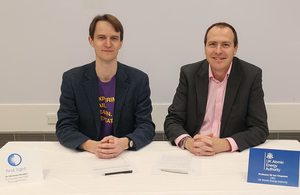 The UK Atomic Energy Authority (UKAEA) and First Light Fusion have signed an agreement for a facility to house First Light’s Machine 4 at UKAEA’s Culham Campus in Oxfordshire. The announcement of the design and construction of the new purpose-built building follows the recent confirmation of net energy gain by the US National Ignition Facility (NIF), at Lawrence Livermore National Laboratory.
The UK Atomic Energy Authority (UKAEA) and First Light Fusion have signed an agreement for a facility to house First Light’s Machine 4 at UKAEA’s Culham Campus in Oxfordshire. The announcement of the design and construction of the new purpose-built building follows the recent confirmation of net energy gain by the US National Ignition Facility (NIF), at Lawrence Livermore National Laboratory.
First Light’s inertial confinement approach to fusion method leverages the same physics proven by NIF. However, it combines this with a unique approach which involves firing a projectile at a fuel pellet to force it to fuse and produce energy. The approach has been validated by UKAEA.
Machine 4 is not intended to generate power, but will be used to develop technology needed for future inertial confinement fusion energy power plants. First Light has worked with UKAEA for many years and believes locating Machine 4 at Culham Campus will bring significant advantages. It will expedite development of the technology and can benefit from UKAEA’s existing expertise and supply chain infrastructure.
First Light says similar technology to its inertial confinement is being developed in the USA. The Z-machine at Sandia National Laboratory is currently the largest ‘pulsed power’ machine in the world. It uses high magnetic fields associated with fast, intense electrical currents to produce high temperatures, high pressures, and powerful X-rays for research in high energy density physics.
Machine 4 will have a stored electrical energy of some100 mega joules with the capability of launching projectiles at 60 kms per second. This speed on impact inside the target will accelerate to around 200kms per second as a result of First Light’s exclusive amplifier technology. The amplifier focuses the energy of the projectile into the fusion fuel, boosting the pressure from impact to deliver to the fuel and shaping the waves to produce spherical implosions. First Light’s current pulsed power machine, Machine 3, launches a projectile at some 20kms per second.
First Light is aiming for net energy gain with Machine 4, exemplified by a fuel gain of 100 or more. This machine is the building block for the pilot power plant, validating First Light's simulation codes, while de-risking the design of high-gain targets for power production.
First Light has appointed technical building design specialists, Ramboll, and architects, Scott Brownrigg. Construction is anticipated to begin in 2024 with the aim of starting operations in 2027. First Light was spun out from the University of Oxford in July 2011, with seed capital from IP Group, Parkwalk Advisors and private investors. Invesco and OSI provided follow-on capital.
First Light Co-founder & CEO Dr Nick Hawker said: “With this agreement in place, and contracts signed with designers and architects, we can accelerate our development timeframe.” He added: “The recent gain result from the National Ignition Facility in California proved what we always knew – that inertial confinement fusion works and offers the potential for a faster route to commercial fusion… We’ve already proven fusion. Gain is our next milestone. We are very confident Machine 4 will allow us to achieve this, while we continue to develop plans for a pilot commercial fusion powerplant.”
UKAEA CEO Professor Sir Ian Chapman acknowledged UKAEA’s long relationship with First Light as it worked with them to validate their maiden fusion result in 2022. He noted: “First Light joins other fusion pioneers in working at Culham as we continue to drive UK economic growth and a thriving fusion industry.” Earlier in January, South Oxfordshire District Council Planning Committee granted planning permission for the construction at Culham of a demonstration project being developed by Canada’s General Fusion.
Image: Dr Nick Hawker of First Light Fusion and Professor Sir Ian Chapman of UKAEA at the signing ceremony (courtesy of UKAEA)



